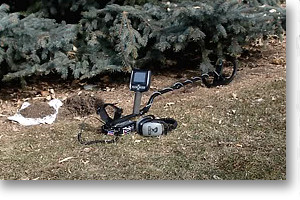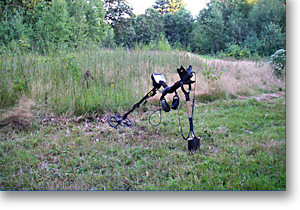
It can be confusing to sort through the myriad of information about metal detectors when making a decision to purchase. The truth is, the decision is an individual one and there is no "right" answer. But before you buy, it is vital that you understand how more expensive metal detectors differ from entry-level machines, and what exactly can be expected when "upgrading" or purchasing a more expensive detector.
What Can I Expect From My Metal Detector?
First and foremost, dispel the notion that a metal detector can unequivocally and accurately identify all metal targets in the ground. This is a point of confusion for many of those new to the hobby. The fact is that a metal detector can determine the conductive properties of a metal object and display that information to the user in any number of different ways. Many targets have the same or similar conductive properties, and it is ultimately up to the detectorist to determine his or her best guess as to what the target actually is. Higher-end detectors can offer more information to an experienced user, and can often display the information in a wider variety of ways, but not even a top-of-the-line detector will tell the user unequivocally what is in the ground. Ultimately, the only way to know for sure is to dig the target. Will you dig trash? Yes. You will dig trash, no matter what detector you use, because the conductive properties of trash frequently overlap with those of desirable targets. If you want to find old coins, relics, or gold items, you will dig trash along the way, and a great deal of it.
It is a common belief among those using an entry-level detector that an upgrade to a more expensive machine will automatically allow for better target identification. This is simply not the case -- at least, not as an automatic process. With experience and practice, a top-end detector will offer the user more information or clues about the target, but these clues must be interpreted by the user in order to make the best guess about what kind of target is in the ground. This is a learned skill and takes a great deal of practice.
How Much Should I Invest?

This is perhaps the most frequently asked question by detectorists who are looking to purchase their first machine, or to upgrade to a new machine. Will a $1000 detector work five times "better" than a $200 detector? Can an entry-level detector find old coins and relics?
At minimum, you should expect to spend at least $200 when purchasing a metal detector. This will get you a good quality entry-level detector for coin or relic hunting. However, you can spend up to $1500 on a top-of-the-line detector. How do you decide which is right for you?
Of course, the most important factor is the limitation of your budget. At the $200 level, two excellent detectors are the Garrett ACE250 and the Fisher F2 (click HERE for a comparison of the two in terms of features). Both are quite popular and will hold their value very well should the user decide to abandon the hobby, or to upgrade to a different detector. However, many ACE250 or F2 users continue to use these machines very successfully and do not find a need to upgrade.
Another factor is the type of soil in your detecting area. If the ground is highly mineralized, an entry level detector may not be the best choice, because it does not allow the user to compensate for the effect of the soil (often referred to as "ground balancing"). Rather, such detectors have a factory-preset ground balance level, whereas most mid-level and upper-end detectors have a feature which allows for cancellation of the ground mineralization effect. Using an entry-level detector with a preset ground balance in highly mineralized soil will result in false signals and instability from the detector as it reacts to the minerals in the ground, ultimately making it less sensitive to desirable buried targets.
You should read as much information as possible on specific detectors on the market so that you understand which features they possess. Many of the features are user preference. For example, some detectors do not have a visual display for target identification but instead rely only on audible tones. Others have a visual display but emit only one, or a limited number, of auditory tones. Some detectors offer a visual digital readout to display a target's conductive characteristics, while some have an analog readout (needle and meter). Most mid to high end detectors offer the ability to ground balance the machine, but some require a manual (user-initiated) process versus an automatic one. The highest end detectors generally offer all such options so that the user can adjust them by preference, and allowing for different adjustments according to the detecting location. Such settings can often be stored as programs in high-end detectors so that the user can easily switch back and forth between preferred settings.

The entry-level detectors tend to have fewer customizable features compared to more expensive models. Specifically, they cannot adjust for ground mineralization, and they allow for a more limited selection of ways to display the target signal (fewer available tones or more limited information on the visual display). Are these features necessary? As mentioned above, such features, when utilized by a seasoned detectorist, can offer more information about the target in the ground, but only if the detectorist knows how to interpret that information. An experienced detectorist who knows the machine well can use the features to their fullest potential, enhancing the ability to find good targets that are deeply buried or that are being masked by nearby trash, for example. Features typically available on higher-end machines generally include a choice of options for the manner in which a target signal is presented (e.g. the ability to amplify the volume or change the tone of the signal, a graphic or numeric display of conductive properties, and more precise discrimination options).
To summarize, an entry-level detector is cost-effective, holds its value well, offers ease of use, and will generally identify coins and relics at depths which most such items are found (up to about six inches). However, its use in highly mineralized ground can adversely affect its capabilities, and it lacks many of the features that more expensive detectors possess. Keep in mind, though, that these features require the user to spend much time becoming acquainted with the detector and experimenting in the field before they can be optimally used. In other words, a novice user will need to commit to learning the features and settings available on a high-end machine in order to benefit from them. A detectorist who is not able or willing to put such time into learning the machine is not going to produce the desired finds that a more seasoned detectorist will, no matter what detector is used. In fact, it can even be counter-productive to use a high-end machine without fully understanding the settings, because adjusting one setting can affect other settings detrimentally.
No matter what your choice, remember to do your research on what is available. And ask questions! There are many experienced users here on American Detectorist who can offer advice, information, and guidance. Welcome to this wonderful and rewarding hobby!
|